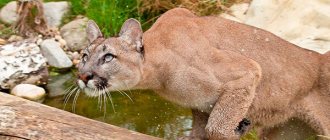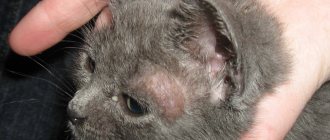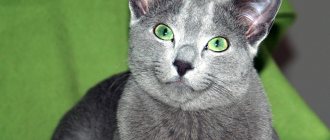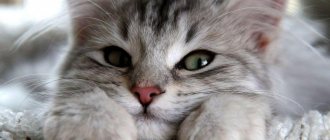The cat family includes 37 species, including cheetahs, pumas, jaguars, leopards, lions, lynxes, tigers and domestic cats. Wild cats live in all regions except Australia and Antarctica. Predators live in different places, but most often in forests.
The fur is decorated with spots or stripes, only the puma, jaguarundi and lion are of a uniform color. Black or almost black fur is found in individuals of several species. The lynx has a short tail, but most cats have a long tail, about a third of their body length. The only cat with a mane is a male African lion. Cats have sharp claws that retract, with the exception of the cheetah. In most cats, the male is larger than the female.
Clouded leopard
It has short legs, a long head, and large upper canines that are proportionally longer than those of any other cat.
Leopard
The solitary animal lives among bushes and forests. Mainly nocturnal, sometimes basking in the sun.
African lion
A muscular cat with a long body, large head and short legs. Size and appearance differ between the sexes.
Ussuri (Amur) tiger
Well adapted to harsh, snowy winters and many different biotopes. Male territories extend up to 1,000 km2.
South China tiger
The stripes of this subspecies are especially wide and spaced further apart than those of other tigers. This gives the fur a bright, impressive appearance.
Bengal tiger
This is a mammal with thick paws, strong fangs and jaws, and fur with a characteristic pattern and color. Males are larger than females.
White Tiger
A striking feature is the fur, the color due to the lack of the pigment pheomelanin, which Bengal tigers possess.
Black Panther
Incredibly smart and dexterous animals that people rarely notice in nature, since they are usually very secretive and cautious.
Jaguar
A lone predator hunts from ambushes. The name comes from an Indian word meaning "one who kills with one leap."
Snow Leopard
The coat consists of a dense undercoat and a thick outer coat that is pale grayish in color with dark spots and a stripe down the spine.
Cheetah
Active during the day, hunting early in the morning and late in the evening. It consumes prey quickly so as not to be captured by lions, leopards, jackals and hyenas.
Caracal
A short-haired cat with reddish-brown smooth fur and long tufts of black fur at the tips of its pointed ears.
African golden cat
Rodents tend to be the most common prey species, but small mammals, birds and primates are also eaten.
Kalimantan cat
For more than a hundred years, researchers could not catch a living cat. She has bright red fur with white stripes on her face and white under her tail.
Temminck's cat
Carnivorous, feeding on small prey such as the Indochinese ground squirrel, snakes and other reptiles, muntjacs, rodents, birds and young hares.
Chinese cat
With the exception of color, the cat resembles the European wildcat. Sandy fur with dark hairs, whitish belly, paws and tail with black rings.
Black-footed cat
Native to the southwestern part of Southern Africa, it lives in extremely dry conditions. It is one of the most brutal predators - 60% of hunting success.
Forest cat
Similar to a domestic cat, but with longer legs, a larger, flatter head and a relatively short tail ending in a rounded tip.
Dune cat
The coat is light sandy to grey-brown, slightly darker on the back and paler on the belly, with sparse stripes on the paws.
jungle cat
Most common in India, Bangladesh and Pakistan, Egypt, Southwest, Southeast and Central Asia, the range is expanding to southern China.
History of the discovery of the species
A small inhabitant of the highlands of Latin America was first described by a scientist from Italy, Emilio Cornalli, in the middle of the nineteenth century.
This animal is so secretive that even today there are simply no reliable facts about its way of life.
In 1865, scientists also demanded unconditional facts proving the existence of a mysterious animal, but apart from the skins of animals that occasionally appeared in Indian markets, there was nothing to present to the world community.
It was only in the 90s of the last century that photographs of Andean cats appeared, and at the end of the century the elusive animal was tracked down by researcher and naturalist Jim Sanderson on the border of Peru and Chile. The scientist was able to approach the predator at arm's length and take a series of photographs. At the same time, the Andean cat completely ignored the person and did not show any signs of aggression.
A pair of Andean mountain cats was found at the beginning of this century in the Argentine reserve Caverna de Las Brajas.
Moreover, one of the specimens was a female with cubs, hiding in a small cave high in the mountains. The reserve employee even managed to take a few photographs.
In 2004, in a national park in Bolivia, one such cat was even captured and radio-collared. Observations were carried out for no more than a year, were very meager and only made it possible to confirm the nocturnal lifestyle of the small predator. Soon the individual died in a poacher's trap.
All researchers note that it is impossible to see the same animal twice. The distrustful and secretive animal immediately changes its location after the slightest contact with a person.
Nevertheless, the description made by an Italian scientist in 1865 is fully confirmed based on accumulated facts.
According to the testimony of South American Indians, earlier populations of these animals were more numerous, but cats were simply stoned to death as soon as they approached human camps.
For some reason, killing this animal was considered the greatest achievement. No one has ever managed to tame the distrustful predator. The Indians reported that in captivity the Andean cat is not able to live even a year, it refuses food and water, and simply dies.
Apparently, this attitude of people has developed in the predator a stable habit of carefully hiding, as well as migrating to the most inaccessible mountainous areas.
Most likely, the population of Andean mountain cats is the smallest on Earth and barely amounts to two and a half thousand individuals.
Mr. Cat recommends: characteristics, habitat
The Andean mountain cat (Leopardus jacobitus) is a small, high-altitude wild cat that is now listed as critically endangered on the IUCN Red List because there are fewer than 2,500 specimens of the creatures alive in the world, scientists believe. , still exist in the wild.
The species was first described by Emilio Cornalli, who named it after the Jacobite Mantegazza.
The Andean mountain cat has ash-gray fur, a darker shade of the head, ears and muzzle. The areas around the lips and cheeks are white, with two dark brown lines running from the corners of the eyes through the cheekbones. There are several black spots on the front legs, yellowish-brown markings on the sides, and up to two narrow dark rings on the hind legs. The long, bushy tail has 6 to 9 rings, ranging from dark brown to black.
The markings of the young are darker and less pronounced than those of sexually mature individuals. The skulls of adults range from 100.4 to 114.8 mm or more in length, and are somewhat larger than those of Pampas and domestic cats.
The Andean mountain cat has a black nose, lips and rounded ears. On the back and tail the hair is 40-45 mm long. Its rounded toes are 4 cm long and 3.5 cm wide. The paw pads are covered with hard hairs, which allows it to move on hot rocks in summer or cold rocks in winter.
The size of adult individuals varies from 57.7 to 85 cm in length from head to rump, long tail from 41.3 to 48.5 cm. Height at the withers is about 36 cm, and body weight is up to 5.5 kg.
The South American mountain cat lives only at high altitudes in the Andes. Camera footage from observers in Argentina, only made public in 2000, shows it ranges in altitude from 1,800 m above sea level in the southern Andes to over 4,000 m in Chile, Bolivia and central Peru.
The area is extremely arid, with sparse vegetation, rocky and steep. The Andean cat population of the Salar de Surire Nature Reserve was estimated at five individuals in an area of 250 square meters. km.
A survey of observers and local people in the province of Jujuy in northwestern Argentina indicates densities of 7 to 12 individuals per 100 square meters. km. at an altitude of about 4200 m above sea level.
Andean mountain cats are found locally. Their Andean habitat is fragmented by deep valleys.
Scientists in some scientific classifications classify the Andean cat as a separate genus Oreailurus, but official ones still classify it as a tiger Leopardus, which also includes their closest relative Ocelot.
Other members of the cat family
Steppe cat
It slowly approaches and attacks, pouncing on the victim as soon as it is within reach (about a meter). Active at night and at dusk.
grass cat
Color varies from grayish yellow and yellowish white to brown, taupe, light gray and silver gray.
Andean cat
They do not live in captivity. All Andean mountain cats in zoos have died. Fewer than 2,500 specimens are thought to exist in the wild.
Geoffroy's cat
Gray or brown with black markings, 90 cm long, of which the tail is 40 cm. Breeds once a year, litters consist of 2-3 kittens.
Chilean cat
The base color of the coat ranges from gray and reddish to bright brown or dark brown, with small rounded black spots.
Long-tailed cat
Lives in forests, is nocturnal, feeds on birds, frogs and insects. Claws and paws allow you to move through trees and along branches.
Far Eastern forest cat
The coat is usually yellowish or reddish-brown above, white below, and heavily marked with dark spots and streaks.
Oncilla
Lives in mountainous, subtropical forests and semi-arid areas. The oncilla was hunted for its beautiful fur in the second half of the 20th century.
Ocylot
The short, smooth fur is decorated with elongated spots with black edges, they are arranged in the form of chains. The upperparts are light or yellowish-brown to gray.
Pampas cat (bell)
About 60 cm long, including a 30 cm tail. The longhaired fur is grayish with brown markings, which are fuzzy in some cats.
Serval
A slender cat with a long neck, small head and large, slightly cupped ears. Adults range from 80 to 100 cm in length, with the tail accounting for another 20–30 cm.
Canada lynx
She has a short tail, long paws, wide toes, and ear tufts raised high. The fur is light gray, the belly is brownish, the ears and tip of the tail are black.
Common lynx
Considered to be a secretive creature. The sounds it makes are quiet and inaudible; the lynx remains unnoticed by foresters for many years!
Iberian lynx
The basis of the diet is rabbit. During the winter months, when the rabbit population is low, it preys on deer, fallow deer, mouflon and ducks.
Red Lynx
About 2 times the size of a domestic cat. Thick short hair perfectly camouflages among trees under the glare of the sun.
Manul
The broad head with high-set eyes and low-set ears squeezes into rocky outcroppings where rodents and birds live.
Marble cat
The coat is long, soft, pale brown to brownish-gray in color, with large spots with dark edges on the body and small dark spots on the legs and tail.
Bengal cat
Nothing escapes her attention. The cat enjoys playing games and learns tricks. Hunts aquarium and pond fish if he lives in the house.
Iriomotean cat
It is found in subtropical forests on the island of Iriomote, preferring areas near rivers, forest edges and places with low humidity.
Sumatran cat
Adapted for aquatic hunting: long muzzle, flattened upper part of the skull and unusually small ears, large and close-set eyes.
Spotted ginger cat
One of the smallest cat species in the world, about half the size of a domestic cat. This animal is rarely seen in nature.
Fishing cat
The coat is pale gray to dark brown, with dark spots and streaks. Lives near water in jungles, reed beds and swamps.
Puma
Lives among desert scrub, chaparral, swamps and forests, avoiding agricultural areas, plains and other places without shelter.
Jaguarundi
Smooth long body with small ears, short legs and a long tail. Length from 90 to 130 cm, including tail from 30 to 60 cm.
Central Asian leopard
Due to differences in habitat, size and color are difficult to determine. The animals in northern Iran are some of the largest leopards in the world.
Far Eastern leopard
Adapted to cold weather, thick fur reaches 7.5 cm in length in winter. For camouflage in the snow, their coat is paler than that of other subspecies.
Asiatic cheetah
Each cheetah has its own dot pattern on its body. Experts use photographs taken by camera traps to identify animals by their unique spots.
Morphological differences between Andean and Pampas cats
The Andean mountain cat and the Pampas cat look almost identical. This makes it difficult to determine which animal is being observed and makes it difficult to properly estimate populations.
Pampas cat
This can be confusing when trying to get the correct information from observations of naturalists who have seen one of these cats but do not realize that they need to look for specific features to differentiate between the two species.
The characteristics of both types of small cats are shown in the table:
| Andean mountain cat | Features | Pampas cat |
| Two thirds of the total body length. Thick and blunt at the tip with 6-9 wide rings. | Tail | Half of the total body length. Thin and pointed at the tip, with 9 thin rings. |
| The maximum width of the ring marks is about 6 cm. | Ring markings on tail | The maximum width of the rings is 2 cm. |
| Characteristic lines on the sides of the eyes. Rounded ear tips. | Description of the muzzle | If stripes are present, they are brown and less pronounced. Triangular-tipped ears are characteristic of most representatives of this species. |
| Very dark or black. | Nose | Light, usually with pink lobe. |
| Yellowish, rusty or grayish and charcoal shades. | Color | Beige, cream, reddish, rust and anthracite colors. |
| One consistent pattern type. | Markings | Three different fur patterns with different variations. |
| Uniform coloring of the main color. | Ear color | Patterned colored ears. |
| The rings are not completely closed, the stripes look like spots. | Front paw coloring | Two or more clear, full, black rings. |
Description of the species
The species has still been practically not studied in natural conditions - even descriptions of the appearance and habits of animals were compiled mainly in zoos.
The secretive Chinese cat can only be seen properly in a zoo
External data
Externally, the Chinese mountain cat is so similar to the European wild cat that it can be mistaken for an enlarged copy of the European cat, but in fact they are completely different species. The “Chinese” has a strong, stocky body and short, strong legs, with which it digs out rodent burrows in search of prey. The muzzle is wide and rounded, large ears are crowned with long tassels. The thick fluffy tail is decorated at the base with several dark rings.
The striped coat of the mountain cat changes its color according to the seasons - in winter the animal's color becomes darker. The fur is dense and rather long, with a well-developed undercoat - grayish-brown on the back and sides and much lighter on the belly. The fur grows abundantly even between the paw pads - this is a unique property of the Chinese mountain cat and is not found in any other species of wild cats.
Chinese mountain cats and European wild cats look like twins
The average weight of an animal is 5–6 kilograms, but there are also much more powerful specimens; males are significantly larger than females. The maximum body length can reach a meter, another approximately 30 centimeters is on the tail, the height of a large male at the withers does not exceed 55 centimeters.
Video: features of the Chinese mountain cat
Lifestyle and nutrition
Like many wild cats, representatives of this species go hunting mainly at night and are very active at dusk, and during daylight hours they sleep in burrows, hollows and rock crevices. Predators are very secretive and cautious; they pay great attention to the safety of their home. Females are especially successful in this - after all, their shelters also become “children’s rooms” during the period of raising offspring. The burrows of females are branched, zoned labyrinths with several well-camouflaged exits, while the burrows of males are much simpler and, as a rule, have only one exit.
Chinese cat goes hunting at dusk
Chinese mountain cats are naturally endowed with an excellent arsenal for night hunting - excellent sense of smell, hearing and vision. Predators “listen” for underground inhabitants: zokors and other rodents, as well as moles, right in their burrows, and then quickly dig up the ground and catch their prey. A wild cat has enough endurance to calmly and carefully track its prey for a long time - then a lightning-fast attack follows.
This cat prefers to walk on her own
These animals prefer solitude and never gather in packs, except for the breeding season; they vigilantly guard the boundaries of their hunting areas, the territory of which usually does not exceed fifteen kilometers.
Reproduction
The mating season lasts from January to March - during this time, females and males unite in pairs; according to some assumptions, a female can mate with several males. After two to two and a half months, kittens are born; there are usually no more than four of them in a litter. The female is responsible for feeding and raising the offspring independently. She arranges her home in advance to create a nest for her cubs.
Chinese mountain cats are caring mothers
By seven to eight months, babies reach the size of their mother and become so independent that they can already live separately from her. For some time, adolescents remain close to the den, but then leave and occupy separate territories. Up to a year, young animals have time to fully develop and become sexually mature.
Features of behavior
The usual climatic conditions for Andean cats are rocks, high mountain ranges, steep mountain slopes, dry, cold or too hot air, low rainfall.
The environment has made this predator a creature with a high degree of survival in conditions of hot summers and very cold winters, an almost complete absence of flora and water sources. Although outwardly the Andean cat is not very different from its domestic relatives, it is an extremely hardy animal that can safely enter into battle with an enemy superior in strength and size.
This is an extremely dexterous and maneuverable creature that moves without fear along almost vertical rocks, is not afraid of enormous heights, easily overcomes any obstacles, performing incredible somersaults and jumps in the air, changing the direction of movement right in flight.
The Andean cat has a perfect hearing aid that allows it to detect the slightest rustles of potential prey and enemies.
The animal's vision and sense of smell are also excellent. In behavioral reactions, this animal is similar to its Pampas counterpart, with which it periodically intersects in its native habitat.
This is a characteristic nocturnal solitary predator that mates only during the mating season.
Recent research by scientists suggests that the hunting grounds of each Andean predator occupy from 35 to 70 square meters. km. Their border is marked by physiological secretions and scrapes, which are periodically renewed. At the same time, the territories of male and female individuals, unlike representatives of other cat species, do not overlap.
The animal practically blends in color with the mountain landscape due to its grayish color, so it is very difficult to detect.
An excellent balancer – a long and thick tail – helps the animal change the direction of its jump in the air. Thick and dense fur perfectly protects the cat from the harsh winter.
The animal is content with a small amount of moisture, which it obtains mostly from melted mountain springs and from living food.
Read: 47 representatives of the cat family and their photos.
Characteristic
The cat family (Felidae) includes mammalian predators with common characteristic features: lifestyle, type of nutrition and reproduction, morphology, hunting habits.
Morphology
The sizes of representatives of the cat family range from 30 cm to 4 m, body weight - from 1 kg to 300 kg. Males differ from females in their greater mass, impressive dimensions and additional external features (lion's mane). The largest in the family are lions and tigers, the smallest are black-footed and spotted cats.
Paw structure: 5 toes on the front paws, 4 toes on the hind feet. Sharp claws tend to hide under the paw pads. Cheetahs, as well as Sumatrans, do not possess the latter quality.
Number of teeth: 28-30. This is much less than other known predators. This corresponds to the specific structure of the head: a rounded skull with a short muzzle. With a small number of teeth, effectiveness is achieved by a strong bite. The long, cone-shaped fangs easily tear through the flesh of prey with minimal jaw force. The teeth located behind the cheeks are used to tear pieces of meat from the victim’s body.
The rough tongue is used to lick the remaining meat from the bones of prey and to keep the skin clean.
Long tail, sometimes with a tassel at the end.
The coat is most often short and thick, although differences in density and length are possible depending on the climatic zone of the habitat.
The color palette of the skin varies from brown to gray. Types of colors: plain, spotted, patterned, striped. There are entirely black individuals or (much less often) albinos. The animal's color may change as it grows. For example, lion or puma cubs are covered in spots, while adults have a solid color. The back and outer surface of the limbs are darker than other areas. The animal's muzzle, forehead and tail usually have markings in the form of spots or lines.
Lifestyle
All cats are characterized by excellent functioning of the organs of vision, an expanded range of perception of sounds, up to ultrasonic frequencies. The sense of smell is also good, but in terms of sensitivity it lags slightly behind the two primary indicators.
These animals usually show maximum activity in the dark. Night time is for hunting, day time is for rest.
Lifestyle – solitary or gregarious. At the head of the pack (pride) is a strong aggressive male, who directs the entire life of the community.
A distinctive feature is to make specific sounds (purring). Small cats can purr while inhaling and exhaling, but large cats can only purr while exhaling. Other sounds: roar, hiss, scream, meow. Loud roars are the privilege of large predators. The structure of the hyoid bone does not allow small cats to roar.
Members of the cat family owe their silent movement and the ability to make quick, easy jumps to their toe-based gait.
The process of tracking the victim is simplified thanks to an additional mirror layer on the iris of the eye. This feature allows furry hunters to examine objects at night. In low light, a cat sees 7 times better than a human.
The vertical modification of the pupil provides the predator with a wide view, and the width of the slit is adjusted depending on the light level.
Equipped with muscles, the ears can easily change their geometry, creating a three-dimensional picture of the surrounding world thanks to signals coming from different directions.
Vibrissae, which are commonly called whiskers, are an organ of the “sixth sense” that sends signals to the brain perceived from the environment. Sensors on the paw pads provide information about humidity, atmospheric pressure, and temperature.
An additional olfactory receptor is designed to recognize individuals of the opposite sex.
With rare exceptions, relatives of cats move freely on vertical surfaces and climb to great heights.
The internal etiquette of relationships requires caution and the exchange of signals indicating mood. Unbridled aggression is not the norm of communication.
Like other predators, relatives of cats mark their habitat by secreting a liquid with a specific odor and leaving marks with the help of their claws.
Reproduction
Representatives of cats are distinguished by polygamy. The head of the pack mates with all the females of the pride, so most members of the pack are blood relatives. A wide variety of genes and little competition between males ensure the survival of the young. The season of readiness for mating in females lasts 1-20 days and resumes until fertilization occurs. During the period of estrus, the female calls her partner with special signals and marks the places near the mating area with an odorous liquid.
Competition between male specimens for the attention of a female is expressed in fights, signs of attention, and poses expressing submissiveness (bowed head). The duration of coitus is less than a minute, the act is repeated many times until the girlfriend becomes pregnant. At the end of estrus, the male sets out in search of a new passion.
For animals living in cold zones, the mating season coincides with the warm season.
Small pussies give birth 2-3 times a year, large ones - once every 18 months. Newborn babies are not adapted to independent living and feeding; their visual organs open some time after birth. The mother usually raises the offspring, but for some species nature made an exception and allowed the fathers to also take care of the children. The interval between births depends on several parameters: the rate at which the babies grow up, their size, and the amount of food available in the region where they live. If the litter dies, the female is again ready for mating after 10-20 days.
The number of babies in a litter ranges from 2-4 to 8-10. Small females are ready for pregnancy by the end of the first year of life, carry the cubs for 2 months and keep the offspring breastfed for a month. Large predators learn the joy of motherhood at the age of 3-4 years, carry babies in their wombs for 3 months, and teach their children to solid food 3 months after birth.
Life span is from 10 to 30 years. Minor kittens are exposed to many dangers: death from predatory animals, developmental defects, mother's refusal to feed, cannibalism.
Nutrition
Predatory cats living in the wild feed almost exclusively on meat obtained by hunting. Carrion is rarely of interest to these animals. The diet includes a small amount of herbs to cleanse the stomach of poorly digestible foods. Residents of hot countries add fruit and vegetable desserts to the menu to restore water balance in the body.
Large animals prefer to feed on ungulates, while small animals prefer to eat rodents, birds, and sometimes fish and amphibians.
Unlike cat cubs, other animals are not dangerous to adult predators. Some animals suffer from infection with ecto- and endoparasites (worms, lice, ticks, etc.)
Diet
Mountain Andean cats are secretive and cautious hunters; there is only speculative information about their diet. Most likely, this is an extremely poor choice due to the small amount of potential prey in the animal’s natural habitats:
- The mountain spotted viscacha is a large rodent, weighing up to three kilograms, resembling a rabbit in appearance.
- The chinchilla is a crepuscular rodent that lives in colonies.
The Andes Mountains are home to six different species of predators, three of them being cats, the Andean cat, the Pampas cat and the puma.
Of these, the puma is a large predator, and the Andean cat and the Pampas cat are medium-sized predators and are very similar. They both hunt in the same territory and the same prey due to the low genetic diversity of the area.
Vizcacha accounts for 93.9% of the biomass consumed in the Andean cat's diet. This is due to the fact that there are significantly fewer other prey objects, in addition, these rodents also lead a crepuscular lifestyle. And the Pampas cat depends on Vizcacha by 74.8%.
In some areas, the mountainous Vizcach will account for 53% of the Andean cat's production.
By the way, researchers believe that in those areas where there are few colonies of viscachas and chinchillas, Andean cats can hunt during daylight hours.
Genetic classification
Genetic analysis has added new possibilities to the traditional classification based on morphological characteristics, making it possible to rank cats into 8 groups:
- Lions, Tigers and Clouded Leopards, united under the name Panthers.
- A combination of Katopum and Marble cats called Kalimantan cats.
- Caracals.
- Ocelots (8 South American species).
- Lynxes.
- Cougars and Cheetahs under the name Puma.
- Asian species + Pallas's cat are included in the Bengal group.
- Homemade.
Puberty and reproduction
Thanks to observations by residents of the Andean mountains of cats paired with the opposite sex and with kittens, it can theoretically be assumed that the predator's mating season lasts from July to August. Since kittens were spotted in April and October, it is believed that the mating season may extend into November or even December.
A litter usually consists of one or two kittens born during the spring and summer months. This is typical for many other cat species, which also give birth to young during periods when food supplies are sufficient.
Puberty, as scientists suggest, occurs in animals closer to two years, and the average life expectancy does not exceed ten years.
Keeping the Andean cat in captivity
This rarest animal in the world is not kept in any zoo in the world.
Besides the fact that the Andean mountain cat is extremely difficult to catch, it simply does not survive in captivity.
Information about the residence of these cats in nature reserves and national parks of South America is extremely rare.
This animal is strictly protected, so its illegal resale is punishable by law in the same way as hunting it or trading in skins and any other body parts.
Population protection
In 2002, the Andean cat's status was upgraded from Vulnerable to Endangered on the IUCN Red List of Threatened Species.
As the habitat spread across four countries, biologists attempted to collaborate in efforts to protect the species. One of the groups formed was the Committee for the Conservation of Andean Cats, now known as the Andean Cat Union.
The direct threat to these predators is loss of habitat, and the indirect threat is various forms of land use, including mining and water extraction, which could potentially increase as a result of climate change.
Also dangerous are inappropriate pastoral and agricultural practices, unregulated tourism, secondary mineral and water extraction, and oil and gas extraction.
A separate point in preserving the species is in resolving conflicts with small livestock farming, in the fight against insufficient knowledge of the species by members of the local community, protection from dogs, accidental exposure to traps.
Scientists paid special attention to the fight against the religious use of Andean cat skins and taxidermy, hunting animals according to traditional beliefs and superstitions.
The Andean cat's habitat spans four different countries in South America. Each has enacted individual laws to protect this endangered animal.
Each country also has its own protected areas where hunting any animals is completely prohibited.
Naturalist Jim Sanderson is still concerned about the fate of the Andean cat.
Through his efforts, together with Constanza Napolitano, Lilian Villalba, Eliseo Delgado and other researchers, a conservation agreement was concluded between the Andean Cat Union and the non-profit organization Fundación Biodiversitas and the government agency CONAF, responsible for the management of national parks and industrial forests.
Villalba of the Andean Cat Union conducted a major research program, including radio telemetry studies, in the Jastor region of southern Bolivia between 2001 and 2006.
Puma
Puma has many names. (Image credit: JT Chapman / Shutterstock.com)
The puma (Puma concolor) is the most common large cat in the Americas and is known by many other names, including mountain lion and cougar. They can be found from southern Alaska and Canada in the western half of North America to southern Chile in lower South America, according to Panthera, a cat conservation organization. Their range used to be much larger, but they were driven out of eastern North America by humans, with the exception of a small population that still lives in Florida, USA. Many puma populations are believed to be declining in Central and South America due to threats such as habitat loss and illegal poaching, although their status in these regions is largely unknown. ()
The U.S. Forest Service says cougars can be more than 2.4 meters in length, including their tails, and weigh between 59 and 68 kilograms. However, according to the National Wildlife Federation, an American non-profit conservation organization, some cougars can grow even larger, weighing up to 100 kg. Cougars hunt small, medium and large prey throughout their range. In North America, pumas primarily eat deer, according to the IUCN. (, , )
Interesting facts about the Andean cat
The Andean mountain cat is the rarest and least studied animal in Latin America, despite the fact that it has been known to people for a very long time.
One of scientists’ versions of the degeneration of the species is a sharp decline in the populations of mountain chinchillas.
The local population of Chile and Peru has been trying to catch the Andean cat for many years, but almost no attempt has been successful.
Due to the impossibility of keeping the Andean cat in captivity, there is no possibility of creating hybrid species or artificially increasing the population size.
1111











